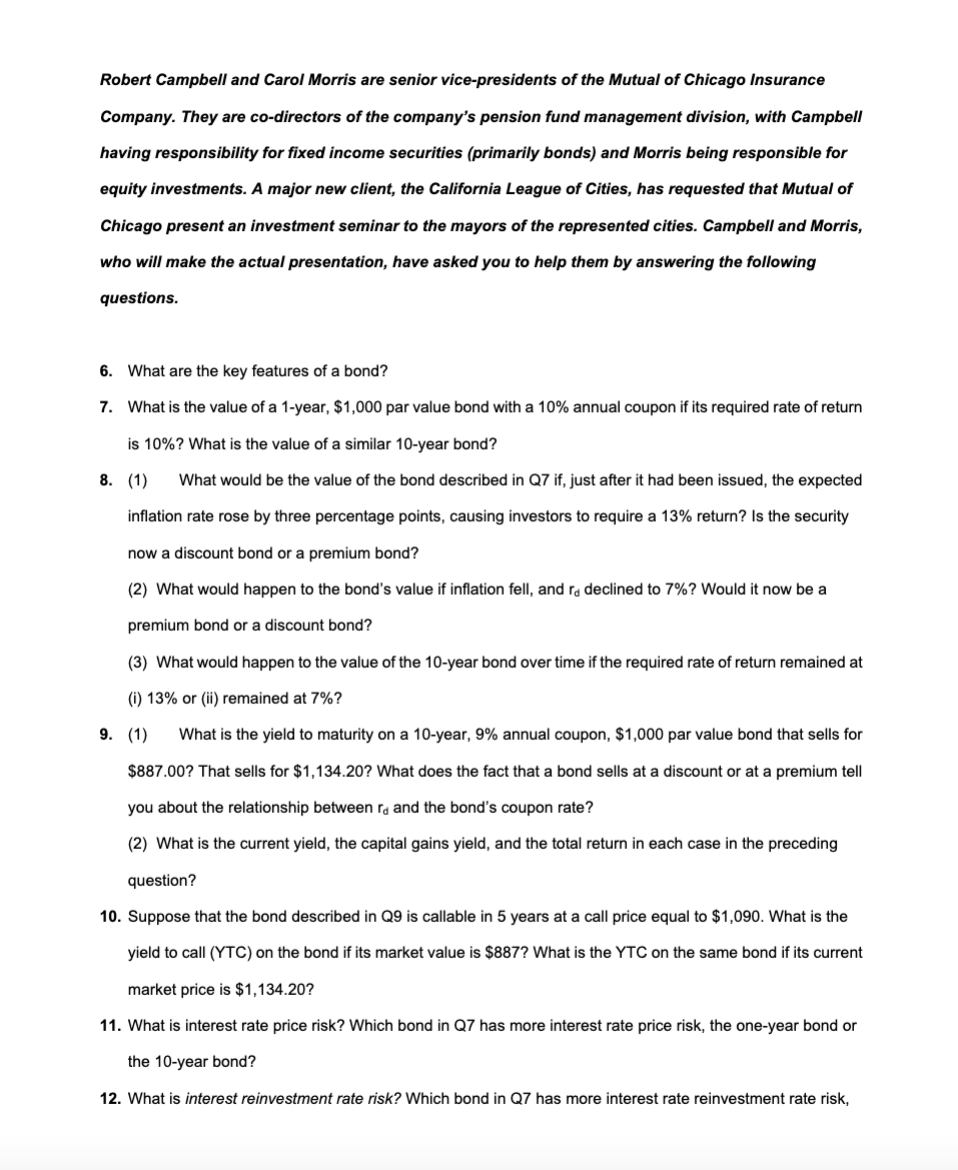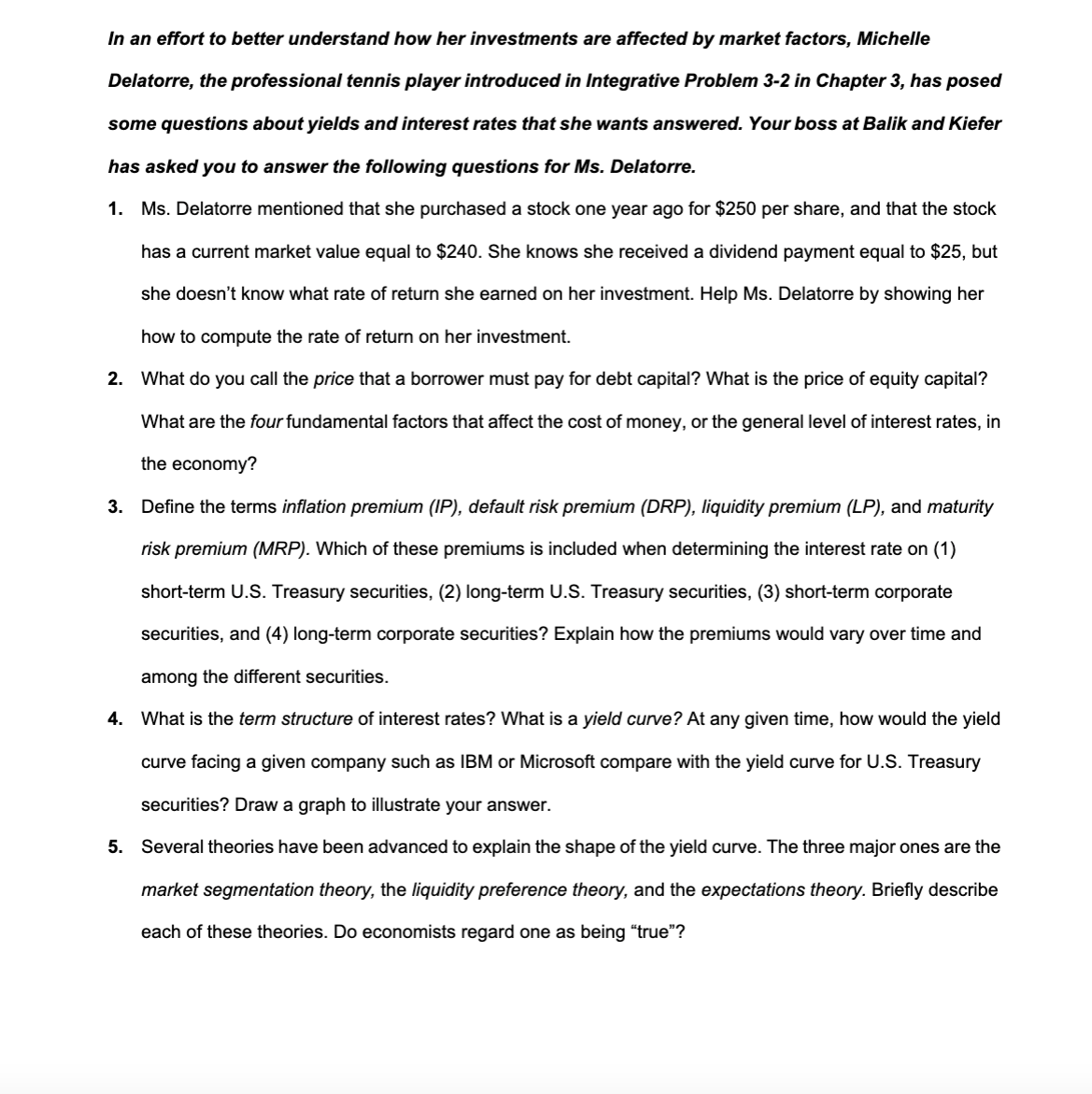Ms. Delatorre mentioned that she purchased a stock one year ago for $250 per share, and that the stock has a current market value equal to $240. She knows she received a dividend payment equal to $25, but she doesn't know what rate of return she earned on her investment. Help Ms. Delatorre by showing her how to compute the rate of return on her investment. What do you call the price that a borrower must pay for debt capital? What is the price of equity capital? What are the four fundamental factors that affect the cost of money, or the general level of interest rates, in the economy? Define the terms inflation premium (IP), default risk premium (DRP), liquidity premium (LP), and maturity risk premium (MRP). Which of these premiums is included when determining the interest rate on (1) short-term U.S. Treasury securities, (2) long-term U.S. Treasury securities, (3) short-term corporate securities, and (4) long-term corporate securities? Explain how the premiums would vary over time and among the different securities.
Ms. Delatorre mentioned that she purchased a stock one year ago for $250 per share, and that the stock has a current market value equal to $240. She knows she received a dividend payment equal to $25, but she doesn't know what rate of return she earned on her investment. Help Ms. Delatorre by showing her how to compute the rate of return on her investment. What do you call the price that a borrower must pay for debt capital? What is the price of equity capital? What are the four fundamental factors that affect the cost of money, or the general level of interest rates, in the economy? Define the terms inflation premium (IP), default risk premium (DRP), liquidity premium (LP), and maturity risk premium (MRP). Which of these premiums is included when determining the interest rate on (1) short-term U.S. Treasury securities, (2) long-term U.S. Treasury securities, (3) short-term corporate securities, and (4) long-term corporate securities? Explain how the premiums would vary over time and among the different securities.
Chapter16: Property Transactions: Capital Gains And Losses
Section: Chapter Questions
Problem 24P
Related questions
Question
please give answer for 1,2,and 3

Transcribed Image Text:Robert Campbell and Carol Morris are senior vice-presidents of the Mutual of Chicago Insurance
Company. They are co-directors of the company's pension fund management division, with Campbell
having responsibility for fixed income securities (primarily bonds) and Morris being responsible for
equity investments. A major new client, the California League of Cities, has requested that Mutual of
Chicago present an investment seminar to the mayors of the represented cities. Campbell and Morris,
who will make the actual presentation, have asked you to help them by answering the following
questions.
6. What are the key features of a bond?
7.
What is the value of a 1-year, $1,000 par value bond with a 10% annual coupon if its required rate of return
is 10%? What is the value of a similar 10-year bond?
8. (1)
What would be the value of the bond described in Q7 if, just after it had been issued, the expected
inflation rate rose by three percentage points, causing investors to require a 13% return? Is the security
now a discount bond or a premium bond?
(2) What would happen to the bond's value if inflation fell, and re declined to 7%? Would it now be a
premium bond or a discount bond?
(3) What would happen to the value of the 10-year bond over time if the required rate of return remained at
(i) 13% or (ii) remained at 7%?
9. (1) What is the yield to maturity on a 10-year, 9% annual coupon, $1,000 par value bond that sells for
$887.00? That sells for $1,134.20? What does the fact that a bond sells at a discount or at a premium tell
you about the relationship between ra and the bond's coupon rate?
(2) What is the current yield, the capital gains yield, and the total return in each case in the preceding
question?
10. Suppose that the bond described in Q9 is callable in 5 years at a call price equal to $1,090. What is the
yield to call (YTC) on the bond if its market value is $887? What is the YTC on the same bond if its current
market price is $1,134.20?
11. What is interest rate price risk? Which bond in Q7 has more interest rate price risk, the one-year bond or
the 10-year bond?
12. What is interest reinvestment rate risk? Which bond in Q7 has more interest rate reinvestment rate risk,

Transcribed Image Text:In an effort to better understand how her investments are affected by market factors, Michelle
Delatorre, the professional tennis player introduced in Integrative Problem 3-2 in Chapter 3, has posed
some questions about yields and interest rates that she wants answered. Your boss at Balik and Kiefer
has asked you to answer the following questions for Ms. Delatorre.
1. Ms. Delatorre mentioned that she purchased a stock one year ago for $250 per share, and that the stock
has a current market value equal to $240. She knows she received a dividend payment equal to $25, but
she doesn't know what rate of return she earned on her investment. Help Ms. Delatorre by showing her
how to compute the rate of return on her investment.
2. What do you call the price that a borrower must pay for debt capital? What is the price of equity capital?
What are the four fundamental factors that affect the cost of money, or the general level of interest rates, in
the economy?
3. Define the terms inflation premium (IP), default risk premium (DRP), liquidity premium (LP), and maturity
risk premium (MRP). Which of these premiums is included when determining the interest rate on (1)
short-term U.S. Treasury securities, (2) long-term U.S. Treasury securities, (3) short-term corporate
securities, and (4) long-term corporate securities? Explain how the premiums would vary over time and
among the different securities.
4. What is the term structure of interest rates? What is a yield curve? At any given time, how would the yield
curve facing a given company such as IBM or Microsoft compare with the yield curve for U.S. Treasury
securities? Draw a graph to illustrate your answer.
5. Several theories have been advanced to explain the shape of the yield curve. The three major ones are the
market segmentation theory, the liquidity preference theory, and the expectations theory. Briefly describe
each of these theories. Do economists regard one as being "true"?
Expert Solution
This question has been solved!
Explore an expertly crafted, step-by-step solution for a thorough understanding of key concepts.
This is a popular solution!
Trending now
This is a popular solution!
Step by step
Solved in 4 steps

Knowledge Booster
Learn more about
Need a deep-dive on the concept behind this application? Look no further. Learn more about this topic, finance and related others by exploring similar questions and additional content below.Recommended textbooks for you

Individual Income Taxes
Accounting
ISBN:
9780357109731
Author:
Hoffman
Publisher:
CENGAGE LEARNING - CONSIGNMENT



Individual Income Taxes
Accounting
ISBN:
9780357109731
Author:
Hoffman
Publisher:
CENGAGE LEARNING - CONSIGNMENT




